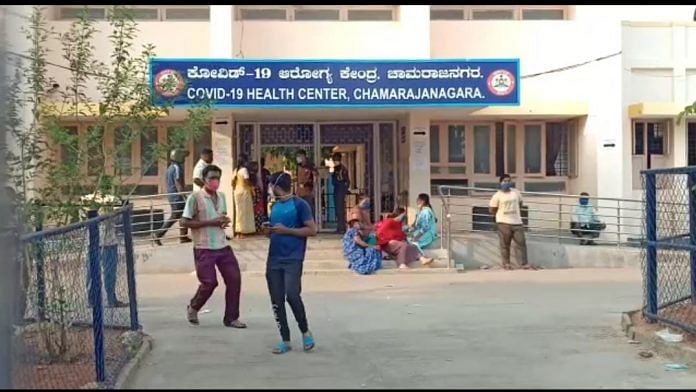Bengaluru: A Karnataka High Court-appointed committee has concluded that 36 deaths — 24 of them on 2 May — at a Covid-19 hospital in Chamrajanagara was caused by the negligence of doctors and the district’s Deputy Commissioner (DC) M.R. Ravi.
The deaths of the 24 patients, 12 of whom were Covid-19 positive, had caused an uproar in Karnataka after relatives alleged that it was due to a lack of oxygen. The BJP government in the state had then denied the charges.
The four-member committee formed to probe the deaths, however, has stated that not just the 24 patients, 12 others too died due to lack of oxygen at the Chamrajanagara Covid-19 hospital.
The committee submitted its 39-page report, a copy of which was accessed by ThePrint, to the Karnataka High Court on 13 May.
The court is scheduled to hear the case on 20 May when it is expected to take stock of what action the state government has taken in the aftermath of the deaths.
‘Chamarajanagara DC failed in his duties’
In its report, the four-member panel has said that the liquid oxygen supply at the hospital in Chamarajanagara, some 180 km from Bengaluru and around 60 km from Mysuru, had been completely exhausted by the evening of 30 April.
Hospital authorities requested a private company Praxair to refill the tank, which was done on 1 May.
According to the report, on 1 May, 117 Covid-19 patients and 46 non-Covid patients were on oxygen support. The total consumption of oxygen that day was 28,84,000 litres.
By 2 May, the hospital consumed 31,00,000 litres of oxygen but it’s supply “was completely exhausted”.
According to the report, the Chamarajanagara DC M.R. Ravi had called a meeting with private oxygen suppliers during the day on 2 May, but “there was not even a whisper about the shortage of oxygen stock at the hospital with any of the agencies at Mysore, with whom MoUs had been entered”.
The oxygen shortage, the reports states, led to the death of 36 patients.
“The hospital authorities have declared the death of 62 persons between 04-05-2021 upto 6.15 am and on 10-05-2021,” the report states. “Out of them, at least 36 were inpatients as on 2-5-2021. The death of these 36 in-patients could be attributed to the non-availability of oxygen during the night 02-05-2021 and early hours of 03-05-2021.”
Holding the Chamarajanagara DC responsible for the tragedy, the report states that he had not “exhibited the dynamism and leadership expected of a district head during a dire crisis situation”.
“As the disaster management committee chairman, he has failed miserably to guide and supervise the crisis situations arising out of the lack of oxygen supply,” the report said.
ThePrint reached Chamarajanagara DC M.R. Ravi but he refused to comment on the issue.
The report, however, dismissed allegations made against the Mysuru Deputy Commissioner Rohini Sindhuri, stating that she caused no hindrance to refilling oxygen cylinders for the hospital.
Also read: Hit hard by 2nd wave, Bengaluru is using Mumbai’s Covid management idea to prepare for 3rd wave
‘CCTV showed nurses and doctors misusing during crucial hours’
The report also alleges that doctors and nurses were negligent in the crucial hours before the tragedy.
The committee has claimed that CCTV footage provided to it from the hospital, showed that while patients were seen lying on the beds, there was no movement of any nurse or duty doctor in the wards nor was there any indication of “minimum unit periodic check up such as pulse, BP or other parameters during the intervening night of 2 May and 3 May when the tragedy took place”.
“One can only see some movement of ward attendants in PPE suits and presumably the transfer of a few dead bodies from the wards to the stretcher,” the report adds. “This gives us an impression that the in-patients were more or less abandoned by the medical personnel to the mercy of the ward boys and attendants.”
The committee has also noted that the district surgeon in-charge left for home at 8.30 pm on May 2. This proved the doctors did not visit the patients and were anything but “hands on”, the committee has said.
The panel also came down heavily on the district hospital authorities for what it termed as minimal documentation of patients, which led to an “unclear trail of clinical care”.
“The entries appear to have been made in one go. There are blanks in certain case sheets with the reference to even the time and date of death,” the report states. “A number of printed forms were blank, even without the particulars of the patient and only containing the signature of the medical officer. Maintenance of case sheets of the patients by both doctors and nurses is sketchy and far from satisfactory.”
The committee also found alleged manipulation and tampering of registers regarding oxygen supply.
In its report, the panel has also made 12 recommendations, including appointing an officer of a rank than the DC to monitor allotment and consumption of oxygen, ensuring minimum buffer stock for at least 24 hours in all hospitals, maintaining proper records of oxygen consumption, stock and receipts and digital display of oxygen balance in real time at all hospitals.
The committee emphasised that all trucks carrying oxygen be fitted with GPS and the families of the deceased be granted compensation.
(Edited by Arun Prashanth)
Also Read: How medical oxygen is supplied to hospitals, and why India is facing an acute shortage



